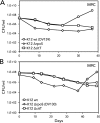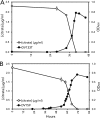Rapid Evolution of Citrate Utilization by Escherichia coli by Direct Selection Requires citT and dctA
- PMID: 26833416
- PMCID: PMC4800869
- DOI: 10.1128/JB.00831-15
Rapid Evolution of Citrate Utilization by Escherichia coli by Direct Selection Requires citT and dctA
Abstract
The isolation of aerobic citrate-utilizing Escherichia coli (Cit(+)) in long-term evolution experiments (LTEE) has been termed a rare, innovative, presumptive speciation event. We hypothesized that direct selection would rapidly yield the same class of E. coli Cit(+) mutants and follow the same genetic trajectory: potentiation, actualization, and refinement. This hypothesis was tested with wild-type E. coli strain B and with K-12 and three K-12 derivatives: an E. coli ΔrpoS::kan mutant (impaired for stationary-phase survival), an E. coli ΔcitT::kan mutant (deleted for the anaerobic citrate/succinate antiporter), and an E. coli ΔdctA::kan mutant (deleted for the aerobic succinate transporter). E. coli underwent adaptation to aerobic citrate metabolism that was readily and repeatedly achieved using minimal medium supplemented with citrate (M9C), M9C with 0.005% glycerol, or M9C with 0.0025% glucose. Forty-six independent E. coli Cit(+) mutants were isolated from all E. coli derivatives except the E. coli ΔcitT::kan mutant. Potentiation/actualization mutations occurred within as few as 12 generations, and refinement mutations occurred within 100 generations. Citrate utilization was confirmed using Simmons, Christensen, and LeMaster Richards citrate media and quantified by mass spectrometry. E. coli Cit(+) mutants grew in clumps and in long incompletely divided chains, a phenotype that was reversible in rich media. Genomic DNA sequencing of four E. coli Cit(+) mutants revealed the required sequence of mutational events leading to a refined Cit(+) mutant. These events showed amplified citT and dctA loci followed by DNA rearrangements consistent with promoter capture events for citT. These mutations were equivalent to the amplification and promoter capture CitT-activating mutations identified in the LTEE.IMPORTANCE E. coli cannot use citrate aerobically. Long-term evolution experiments (LTEE) performed by Blount et al. (Z. D. Blount, J. E. Barrick, C. J. Davidson, and R. E. Lenski, Nature 489:513-518, 2012, http://dx.doi.org/10.1038/nature11514 ) found a single aerobic, citrate-utilizing E. coli strain after 33,000 generations (15 years). This was interpreted as a speciation event. Here we show why it probably was not a speciation event. Using similar media, 46 independent citrate-utilizing mutants were isolated in as few as 12 to 100 generations. Genomic DNA sequencing revealed an amplification of the citT and dctA loci and DNA rearrangements to capture a promoter to express CitT, aerobically. These are members of the same class of mutations identified by the LTEE. We conclude that the rarity of the LTEE mutant was an artifact of the experimental conditions and not a unique evolutionary event. No new genetic information (novel gene function) evolved.
Copyright © 2016, American Society for Microbiology. All Rights Reserved.
Figures






Comment in
-
Reinterpreting Long-Term Evolution Experiments: Is Delayed Adaptation an Example of Historical Contingency or a Consequence of Intermittent Selection?J Bacteriol. 2016 Feb 16;198(7):1009-12. doi: 10.1128/JB.00110-16. J Bacteriol. 2016. PMID: 26883821 Free PMC article.
Similar articles
-
Reinterpreting Long-Term Evolution Experiments: Is Delayed Adaptation an Example of Historical Contingency or a Consequence of Intermittent Selection?J Bacteriol. 2016 Feb 16;198(7):1009-12. doi: 10.1128/JB.00110-16. J Bacteriol. 2016. PMID: 26883821 Free PMC article.
-
Recursive genomewide recombination and sequencing reveals a key refinement step in the evolution of a metabolic innovation in Escherichia coli.Proc Natl Acad Sci U S A. 2014 Feb 11;111(6):2217-22. doi: 10.1073/pnas.1314561111. Epub 2013 Dec 30. Proc Natl Acad Sci U S A. 2014. PMID: 24379390 Free PMC article.
-
The Escherichia coli CitT transporter can be used as a succinate exporter for succinate production.Biosci Biotechnol Biochem. 2021 Mar 24;85(4):981-988. doi: 10.1093/bbb/zbaa109. Biosci Biotechnol Biochem. 2021. PMID: 33590847
-
C4-dicarboxylate carriers and sensors in bacteria.Biochim Biophys Acta. 2002 Jan 17;1553(1-2):39-56. doi: 10.1016/s0005-2728(01)00233-x. Biochim Biophys Acta. 2002. PMID: 11803016 Review.
-
Cooperation of Secondary Transporters and Sensor Kinases in Transmembrane Signalling: The DctA/DcuS and DcuB/DcuS Sensor Complexes of Escherichia coli.Adv Microb Physiol. 2016;68:139-67. doi: 10.1016/bs.ampbs.2016.02.003. Epub 2016 Mar 16. Adv Microb Physiol. 2016. PMID: 27134023 Review.
Cited by
-
Bacterial evolution during human infection: Adapt and live or adapt and die.PLoS Pathog. 2021 Sep 9;17(9):e1009872. doi: 10.1371/journal.ppat.1009872. eCollection 2021 Sep. PLoS Pathog. 2021. PMID: 34499699 Free PMC article. Review.
-
Management of pregnancy in a patient with congenital hyperinsulinism treated with association of diazoxide/calcium channel blocker.Acta Diabetol. 2022 Aug;59(8):1117-1120. doi: 10.1007/s00592-022-01898-9. Epub 2022 May 27. Acta Diabetol. 2022. PMID: 35624321 No abstract available.
-
Rapid functional activation of a horizontally transferred eukaryotic gene in a bacterial genome in the absence of selection.Nucleic Acids Res. 2019 Jul 9;47(12):6351-6359. doi: 10.1093/nar/gkz370. Nucleic Acids Res. 2019. PMID: 31106341 Free PMC article.
-
Evolutionary poker lacks a full deck when modelling the LTEE Cit+ phenotype.J Physiol. 2025 Mar;603(5):1325-1328. doi: 10.1113/JP288355. Epub 2025 Feb 5. J Physiol. 2025. PMID: 39907441 Free PMC article. No abstract available.
-
Reinterpreting Long-Term Evolution Experiments: Is Delayed Adaptation an Example of Historical Contingency or a Consequence of Intermittent Selection?J Bacteriol. 2016 Feb 16;198(7):1009-12. doi: 10.1128/JB.00110-16. J Bacteriol. 2016. PMID: 26883821 Free PMC article.
References
-
- Lenski RE, Rose MR, Simpson SC, Tadler SC. 1991. Long-term experimental evolution in Escherichia coli. I. Adaptation and divergence during 2,000 generations. Am Nat 138:1315–1341.
Publication types
MeSH terms
Substances
Grants and funding
LinkOut - more resources
Full Text Sources
Other Literature Sources

